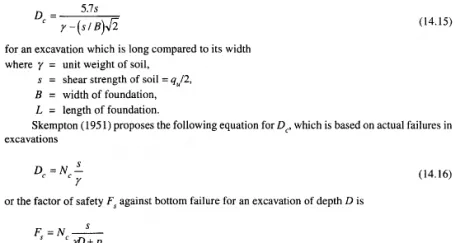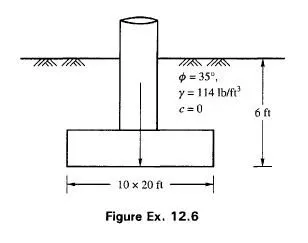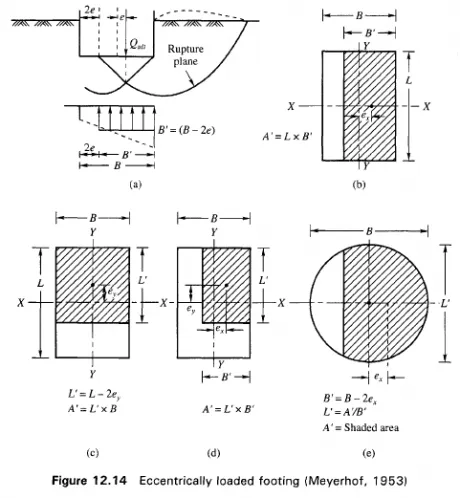General Consideration
A floating foundation for a building is defined as a foundation in which the weight of the building is approximately equal to the full weight including water of the soil removed from the site of the building. This principle of flotation may be explained with reference to Fig. 14.4. Fig. 14.4(a) shows a horizontal ground surface with a horizontal water table at a depth dw below the ground surface. Fig. 14.4(b) shows an excavation made in the ground to a depth D where D > dw, and Fig. 14.4(c) shows a structure built in the excavation and completely filling it. If the weight of the building is equal to the weight of the soil and water removed from the excavation, then it is evident that the total vertical pressure in the soil below depth D in Fig. 14.4(c) is the same as in Fig. 14.4(a) before excavation. Since the water level has not changed, the neutral pressure and the effective pressure are therefore unchanged. Since settlements are caused by an increase in effective vertical pressure, if we could move from Fig. 14.4(a) to Fig. 14.4(c) without the intermediate case of 14.4(b), the building in Fig. 14.4(c) would not settle at all.
This is the principle of a floating foundation, an exact balance of weight removed against weight imposed. The result is zero settlement of the building.
However, it may be noted, that we cannot jump from the stage shown in Fig. 14.4(a) to the stage in Fig. 14.4(c) without passing through stage 14.4(b). The excavation stage of the building is the critical stage.
Cases may arise where we cannot have a fully floating foundation. The foundations of this type are sometimes called partly compensated foundations (as against fully compensated or fully floating foundations).
While dealing with floating foundations, we have to consider the following two types of soils. They are:
Type 1: The foundation soils are of such a strength that shear failure of soil will not occur under the building load but the settlements and particularly differential settlements, will be too large and will constitute failure of the structure. A floating foundation is used to reduce settlements to an acceptable value.
Type 2: The shear strength of the foundation soil is so low that rupture of the soil would occur if the building were to be founded at ground level. In the absence of a strong layer at a reasonable depth, the building can only be built on a floating foundation which reduces the shear stresses to an acceptable value. Solving this problem solves the settlement problem.
In both the cases, a rigid raft or box type of foundation is required for the floating foundation [Fig. I4.4(d)

Problems to be Considered in the Design of a Floating Foundation
The following problems are to be considered during the design and construction stage of a floating foundation.
1. Excavation
The excavation for the foundation has to be done with care. The sides of the excavation should suitably be supported by sheet piling, soldier piles and timber or some other standard method.
2. Dewatering
Dewatering will be necessary when excavation has to be taken below the water table level. Care has to be taken to see that the adjoining structures are not affected due to the lowering of the water table.
3. Critical depth
In Type 2 foundations the shear strength of the soil is low and there is a theoretical limit to the depth
to which an excavation can be made. Terzaghi (1943) has proposed the following equation for
computing the critical depth Dc,

where Nc is the bearing capacity factor as given by Skempton, and p is the surcharge load. The values of Nc may be obtained from Fig 12.13(a). The above equations may be used to determine the
4. Bottom heave
Excavation for foundations reduces the pressure in the soil below the founding depth which results in the heaving of the bottom of the excavation. Any heave which occurs will be reversed and appear as settlement during the construction of the foundation and the building. Though heaving of the bottom of the excavation cannot be avoided it can be minimized to a certain extent. There are three possible causes of heave:
1. Elastic movement of the soil as the existing overburden pressure is removed.
2. A gradual swelling of soil due to the intake of water if there is some delay for placing the foundation on the excavated bottom of the foundation.
3. Plastic inward movement of the surrounding soil.
The last movement of the soil can be avoided by providing proper lateral support to the excavated sides of the trench.
Heaving can be minimized by phasing out excavation in narrow trenches and placing the foundation soon after excavation. It can be minimized by lowering the water table during the excavation process. Friction piles can also be used to minimize the heave. The piles are driven either before excavation commences or when the excavation is at half depth and the pile tops are pushed down to below foundation level. As excavation proceeds, the soil starts to expand but this movement is resisted by the upper part of the piles which go into tension. This heave is prevented or very much reduced.
It is only a practical and pragmatic approach that would lead to a safe and sound settlement free floating (or partly floating) foundation.

